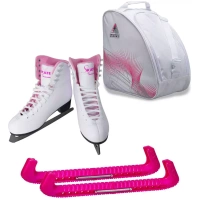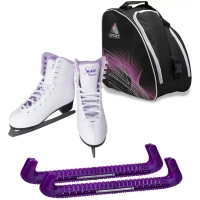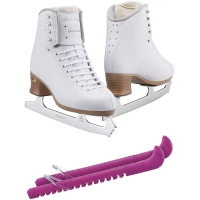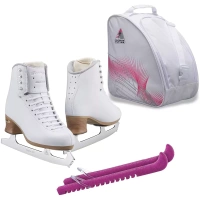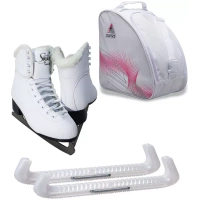If you want to buy a good pair of figure skates for yourself or your child, there are some things you should consider. After all, the quality of the skates determines how well you or your child can perform while wearing them. Safety is another aspect to consider, as beginners’ lack of proper technique can result in falls and injuries.
Bear in mind that recreational or entry-level skates shouldn’t be pricey. You shouldn’t waste money on expensive state-of-the-art ice skates to skate a couple of times every year. However, cheaper options usually provide less comfort and ankle support
Choose the right size of ice skates
One mistake you can make is buying a pair of ice skates that is too big. You should know that proper fit of skates it’s the key to success. It especially concerns figure skates, where control over the blade is essential. Choose a pair that fits quite firm but not too tight. If you have enough space for a finger to fit behind your heel, that will do. Generally, it is a good idea to try on ice skates in the morning or early afternoon when your feet aren’t yet swollen. Don’t forget to take your skating socks with you (you’ll find more on choosing the proper ice skating gear later in this article).
Choosing the right shoe size for kids is harder, as they grow out of shoes so fast. That is why lots of kids’ ice skate models are adjustable in length. That means that the boot can be expanded, so your child can grow up to three or four sizes with the ice skates. Although adjustable ice skates are designed for recreational skating, their quality is as high as in regular models. If your child’s feet are still growing, we recommend adjustable skates.
Sizes vary among companies and manufacturers. To choose the ice skates size accurately, read the manufacturers’ size guides. Make sure to take all the needed measurements properly (Check out our article on how to measure your feet).
How do I select figure skates for beginners?
Most ice skates can be broken down into categories by skill level. This means that the features of ice skates work best for the skill level they are made for, not that an advanced ice skate is better in quality than an intermediate one.
Entry-level / Beginner ice skates
Entry-level / Beginner ice skates are designed for those just starting. They feature softer synthetic boots and linings, PVC soles, and blades that work for basic moves and skating. Entry-level skates aren’t likely to hold up to advanced jumps, and maneuvers.
Intermediate / advanced ice skates
Intermediate / advanced ice skates have boots and blades that perform well at the highest, most demanding levels. Their design is more complicated, which makes them more expensive than most figure skates.
Recreational ice skates
Recreational ice skates are suited for casual skaters. They have a simple lace to put them on and off easily, and basic boots and blades. These ice skates are similar to beginner skates, and will not hold up to advanced jumps, spins and other maneuvers.
Figure skates vs. hockey skates
Both types of ice skates have their pros and cons.
Type of skate define its purpose. The blade of a figure skate is long and straight that can help with balance. They also have toe picks, which contribute to a better performance of advanced figure skating maneuvers like jumps and spins. However, the figure skater can often trip over the toe pick.
The boot comes in genuine or synthetic leather. Genuine leather is used in more expensive figure skates for professional use. The boot is typically harder and thus less comfortable to wear but provides good ankle support. Synthetic leather boots generally are more comfortable to wear but lack ankle support. However, some modern figure ice skates in synthetic leather exceed leather boots in ankle support and have better padding for more comfort.
Hockey skates have a slightly curved and short blade, which gives you more power, acceleration, and quicker turns. On the other hand, they are less suitable for long rides and can make it harder to balance. As there is no toe pick, you are less likely to trip, but nothing stops you from falling forward. Ice hockey skates are used for the most popular of winter games in United Stat – ice hockey, as the name suggests. But they are as good for regular skating for beginners and those ‘in need for speed’.
The stiff shell of the hockey skate protects your feet against hits during an ice hockey game. Despite the stiff shell, soft interior padding makes them comfortable to wear, which can do for beginners looking for comfortable skates. The boot provides excellent support for your ankle and foot.
Which are easier to learn on, figure or hockey skates?
If you are going to take up figure skating in the future, it is best to start with figure skates. The adjustment to the toe pick will be a lot harder if you start with hockey skates and switch to figure skates later. If you intend on playing hockey, we also suggest beginning with figure skates. Many hockey players find it challenging to balance on best hockey skates, especially if they are young and first-time skaters. If you lose balance, you immediately fall forward or backward. You will keep running falling forward when you don’t know how to push with the blade. Learn blade pushes on figure skates, and the adjustment to hockey skates will be rather easy.
Hybrid and 3-in-1 ice skates
Hybrid ice skates combine blades of ice hockey skates or figure skates with soft boots of fitness inline skates. So the transition will be smoother since you get the same comfortable feeling. It’s all about stability and high comfort.
Since figure skates do not provide the same level of comfort, it can be a good idea to buy a pair of hybrid ice skates with a figure skate blade for younger children. This way, they can practice figures without compromising comfort or support. However, on the outside, these skates will no longer have the classic figure skate look.
If your child wants to run on regular comfort skates, you should opt for 3-in-1 skates. You can attach either ice blades, inline wheels or quad roller skate wheels to the boot. This way, the skates can be used all year round, instead of purchasing three pairs. The quality and performance will not be as good as if you bought them separately, though.
If you are still confused which type of ice skates to buy, start by renting different pairs at your local skate rink and give them a pilot test.
What are some tips when ice skating for the first time?
Wear proper clothes
Wear proper clothes that are comfortable for active movement and will not get wet. Skating is exercise, and your body will get warmer once you move around. In an outdoor rink, you want to choose slightly thicker and warmer clothes or add layers.
Put on socks or tights.
Put on socks or tights. To keep your feet nice and warm, you should wear skating tights or microfiber socks. It is crucial that your feet don’t get wet to keep you warm. Use either tights or microfiber cloths when skating, not cotton socks.
Lace-up your boots tight
Lace-up your boots tight around your legs to secure your ankles and make them stable. Make it as tight as you can still walk and stand up. If your legs are going numb, that is too tight. Bear in mind that as you skate, your boots and laces will loosen up a little.
Warm-up first.
Warm up first. A quick warm up before skating is essential. It will prevent your muscles from getting sore, as your body may not be used to the cold.
Master the basics.
Master the basics. Do some basic gliding: march forward and let your body glide. Do it until you feel comfortable. Then, start picking up one foot as you glide. Try stroking: it is the same as gliding except you extend the motion longer. Do swizzles: place your heels together, slide your feet apart. Now, point your toes together. Repeat this move, leaving a trail in the ice resembling an hourglass. Once you feel comfortable skating around the rink doing swizzles, gliding, and stroking, you need to learn how to stop. Stand with your feet together, push them apart while skating and put one skate out sideways. This will push some frost off of the ice and cause your foot to stop.
So which ice skates are the best for beginners?
Now that you are familiar with all the theory, here is our guide to the best ice skates models for beginners. (insert a link to the article “Beginner Guide to Ice Hockey Skates”)
You can also browse through our wide selection of different ice hockey skates and figure skates to find the perfect pair.
Don’t be afraid of falling.
Don’t be afraid of falling, as it is a natural part of the sport. Remember that all olympic figure skaters or world champions of hockey also started from this. Get up and keep trying until you skate like world titleholder of figure skating championship!
Lean forward while you skate.
Lean forward while you skate. When skating, always lean forward slightly. Bend your knees and push your weight forward. Leaning back, you can fall back onto the ice.
Do not look down.
Do not look down. At first, you may be tempted to look down to make sure you’re making the right motions. This will not help you skate better and can result in accidents. Keep your head up, so you do not bump into anyone on the ice.
